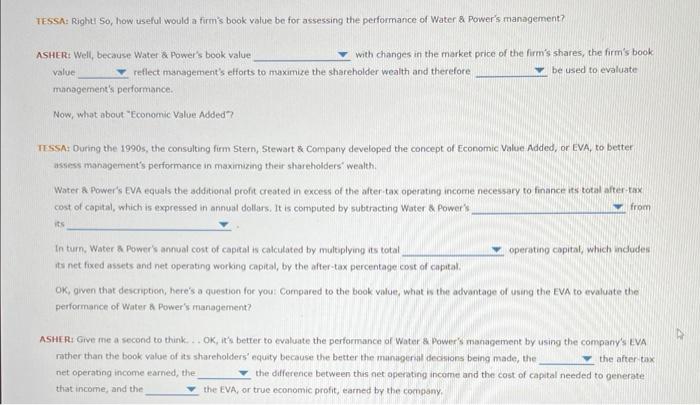7. The relationship between the book value of shareholders' equityand the firm's Market Value Added (MVA) and Economic Value Added (EVA) Yesterday, Water and Power Co. released its 2018 cual report on the company's website. While reading the report for his boss, Asher came across several terms about which he was unsure. He leaned around the wall of his cubicle and asked his colleague, Tessa, for help. ASHER: Tessa, do you have a second to help me with my reading of Water & Power's annual report? I've come across several unfamiliar terms, and I want to make sure that I'm interpreting the data and management's comments correctly. For example, one of the footnotes to the financial statements uses the book value of Water & Power's shares, and then in another place, it uses "Economic Value Added." I've never encountered those terms before. Do you know what they're talking about? TESSA: Yes, I do. Let's see if we can make these terms make sense by talking through their meaning and their significance to investors The term book value has several uses. It can refer to a single asset or the company as a whole. When referring to an individual asset, such as a piece of equipment, book value refers to the asset's adjusted for any accumulated depreciation or amortization expense. The value, or difference between the machine's historical cost and its accumulated depreciation expense, is called its book value. In contrast, when the term refers to the entire company, it means the total value of the companiy's as reported in the firm's ASHER: That makes sense. So, what makes this value important to wwestors is that it is value that can change-but only due to a couple of events, including the of Treasury stock, the sale of new common or preferred shares, and the payment of Equally important, it change in response to changes in the market prices of the firm's shares TESSA: Right! So, how useful would a firm's book value be for assessing the performance of Water a Power's management? TESSA: Right So, how useful would a firm's book value be for assessing the performance of Water & Power's management? ASHER: Well, because Water & Power's book value with changes in the market price of the firm's shares, the firm's book value reflect management's efforts to maximize the shareholder wealth and therefore be used to evaluate management's performance. Now, what about "Economic Value Added? TESSA: During the 1990s, the consulting firm Stern, Stewart & Company developed the concept of Economic Value Added, or EVA, to better assess management's performance in maximizing their shareholders' wealth Water & Power's EVA equals the additional profit created in excess of the alter tax operating income necessary to finance its total after tax cost of capital, which is expressed in annual dollars. It is computed by subtracting Water & Power's from its In turn, Water Power's annual cost of capital is calculated by multiplying its total operating capital, which includes its net fixed assets and net operating working capital, by the after-tax percentage cost of capital OK, given that description, here's a question for your compared to the book value, what is the advantage of using the EVA to evaluate the performance of Water Power's management? ASHER: Give me a second to think OK, it's better to evaluate the performance of Water & Power's management by using the company's EVA rather than the book value of its shareholders' equity because the better the manageral dechon being made, the the after tax net operating income earned, the the difference between this net operating income and the cost of capital needed to generate that income, and the the EVA, or true economic profit, earned by the company








